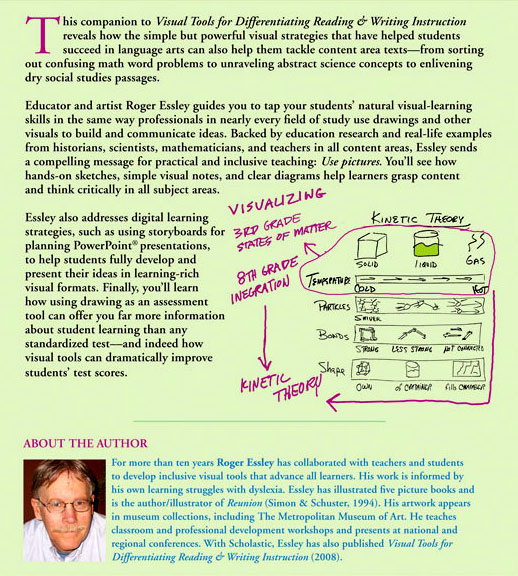Visual Tools for the Content Areas
Look inside Visual Tools in the Content Areas

See how the same Visual Tools that support reading comprehension and make writing easier support learners in vocabulary, math, science, social studies and more.
Teachers in many classrooms show how hands-on drawing with simple visual display makes any content easier to grasp. See how visual notes support readers comprehension of complex content, how simple pictures help students solve math story problems, and how science labs become both more concrete and more detailed when we add visual tools.
Get a preview — download PDFs of the forward and the opening chapter. To enlarge back cover click on it.

See how Smart boards can get smarter when we make them truly interactive and hands-on — download two linked Notebook files created by a middle school science teacher to support content discussion and writing.
Bike Riding News

LEARNING TO RIDE A BIKE — NO PAIN, ALL GAIN!
In the second chapter of Visual Tools in the Content areas I tell a story about learning the hard or easy way. In that story we hear about about a new strategy for learning to ride a bike — and I also promise an update on that bike riding strategy. Here’s exciting bike riding news:
Visual Tools in the Content Areas — Contents Page

Forward by Linda Rief, the well known teacher and author.
Introduction: An Essential Overview of Visual Tools — See how tapping students visual intelligence transforms learning in many classrooms, offering learners the tools scientists and writers use to make content more engaging and ideas more concrete.
Chapter 1 Integrating Visuals Across the Curriculum
— see how visual display tools support 2nd grade animal classification and fifth grade exploration of cultures anchoring and amplify reading, discussion, and writing.
Chapter 2 Building on Natural Literacy Skills: The Learning Tripod
— explore how visual skills are essentially integrated in early learning, and how integrating visual verbal and text skills advances all learners, making inclusive practice a reality for different learners.
Chapter 3 Vocabulary Power: Linking Words, Images, and Ideas Across the Curriculum
— explore linking words and images to make vocabulary more memorable, note taking easier, and how building pictures that connect ideas makes content easier to grasp.
Chapter 4 Teaching Science With the Visual Tools Scientists Use
— see how a coherent use of simple images build understanding science concepts, how visual lab notes make experiments more hands-on meaningful, and how simple pictures build bridges to traditional science visuals like charts and graphs.
Chapter 5 Teaching Social Studies to Connect Learners to Big Themes
— recognizing the power of visual tools in our culture and in the history of literacy connects learners hands-on visual skills with essential social studies themes.
Chapter 6 Teaching Math to Solve and Move Beyond the Story Problem
— See in practical detail how drawing helps learners better visualize math concepts, solve story problems, and increase success on the State test.
Chapter 7 Low-Tech Visual Tools Build High-Tech Understanding
— See how tapping learners visual skills connects students with high-tech tools. We see how simple hands-on tools can make digital presentations more effective, connecting learners with the visual -digital literacy of the 21st century.
Chapter 8 Assessing Students and Assessing Our Own Practice
— We examine the unique value of visual tools for formative assessment, giving teachers a window on learners understanding of content while offering students true.
